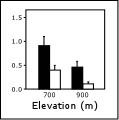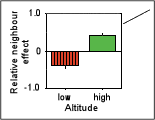 |
|
|
|
|
|
|
The influence of plant neighbours on each other's growth ranges from strong suppression by restricting access to resources (negative interaction - competition) to providing the conditions (for example, as suitable microclimate) essential for any growth at that position (positive interaction - facilitation); all kinds of intermediate relationships between these extremes may also occur. Compared with vegetation in lowland areas, the absolute and relative importance of positive interactions is greater in the high mountains, particularly in the most extreme environments. |
|
Competition is an important interaction in a wide variety of alpine communities. Several typical alpine plant communities are dominated by species which are able to form a dense cover of vegetation (e.g. Carex curvula). These communities usually have a small number of species, because the growth form of the dominant species inhibits the growth of other plants. A high standing dead crop and/or a large amount of litter in some tussock species may further inhibit seedling establishment. Belowground competition may be more important than aboveground competition in many alpine communities, for both the community itself and in comparison to the situation in lowlands. In the Caucasus, in a Caricetum curvulae, lichen biomass may contribute more than 60% to the total aboveground biomass. Yet, belowground, the root systems of Carex curvula may leave so few gaps in the vegetation that seedling establishment of other higher plants is inhibited, whereas lichens are able to grow in the spaces between the tussocks. Although competition may interfere with community development up to the altitudinal limits of plant growth, the relative importance of competition as a community structuring process tends to decrease with environmental harshness (e.g. at high altitudes) and disturbance intensity. Let us look, for instance, at a snow-melt gradient. Few plants can cope with the conditions in the area where the vegetation is only released from snow cover later in summer. Under these conditions the plants are small and competition is low. At the other end of the snow cover gradient, on exposed ridges where high winds prevent snow accumulation, exposure to severe frosts and drought restrict development of the vegetation. In intermediate conditions, however, where snow cover provides shelter and sustains soil moisture without restricting the length of the growth period too much, the productivity and diversity of the vegetation may be highest and the influence of competition strongest for community composition and structure. |
|
|
|
Under harsh environments, the presence of plants can ameliorate the abiotic environment for germination, establishment and growth of the same or different species. For example, the microclimate within cushion plants is not only beneficial for the cushion plant itself, but may also favour the growth and establishment of other plants. Cushion plants can modify wind patterns, temperature, and water and nutrient availability, and act as nurse plants for the seed germination and establishment of other species. |
1 - Silene acaulis (72K) |
|
The number of plant species growing within cushions as a proportion of those in the neighbourhood increases with altitude, suggesting that the nurse plant effect is more important at higher altitudes. This effect may help to maintain species diversity close to the altitudinal limits of higher plant growth by facilitating species which otherwise would not be able to survive there. For other species, the conditions provided by nurse plants may not be obligate, but facilitation enhances the rate of subsequent colonization. |
2 - Nurse effect (10K) |
|
Although the facilitating effect is often crucial for plant establishment in alpine habitats, all growth stages may profit from the presence of neighbours. |
3 - Facilitation (17K) |
|
|
|
The outcome of interspecific interactions depends on the species involved as well as on other factors such as the habitat. |
| Which seven of these statements are likely to be correct: |
29 August 2011 |
||
| |
||


